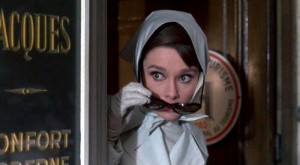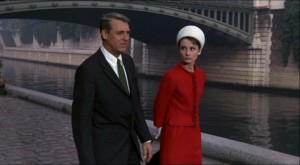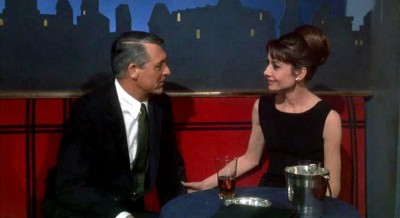
Often spoken of as “the best Alfred Hithcock movie Hitchcock never made,” the truth is that Stanley Donen’s Charade (1963) is much better as sophisticated, sexy entertainment than anything Hitchcock himself was making in the 1960s. In fact by 1963, Hitch would never make anything that was this much pure fun again. This is old-style Hollywood moviemaking — complete with a pair of movie stars that really were (and are) movie stars: Cary Grant and Audrey Hepburn. (It would also be Grant’s last appearance in this kind of film.) It’s every inch a work of style and polish, but don’t let it fool you. This isn’t just a case of somebody “making ‘em like they used to.” Charade is by no means reactionary filmmaking. If anything, it’s the bridge from Stanley Donen’s 1950s filmmaking into the freer style of the 1960s. (Donen is one of the few Hollywood directors who effectively made that transition.) It was probably nothing but luck that brought Donen together with this cast and Peter Stone’s screenplay, but it was the perfect blend for the 1960s — and it remains perfect today. The only film to come close to this kind of entertainment since then is Steven Soderbergh’s Ocean’s Eleven (2001).

The film starts off as what appears to be a straightforward thriller with a body being thrown off a train —followed by Henry Mancini’s unforgetable main theme and Maurice Binder’s swirling pop art opening credits. The tone is set perfectly for a first-rate thriller. And the next scene makes it look like that’s where the film is going — only what appears to be an impending assassination turns out to be a gag. In no time, Cary Grant and Audrey Hepburn (who’ve just met) are exchanging flirtatious repartee, even though she effectively shuts him down (for now) with the classic objection, “I already know an awful lot of people, and until some of them die off I can’t possibly meet anyone else.”

Shortly after that, the plot kicks in, revealing that the man thrown from the train was Hepburn’s now deceased husband. She isn’t exactly heartbroken over the loss, but she’s grimly fascinated by the weird parade of unsavory characters who show up at the funeral — one of whom actually jabs the corpse with a pin in order to make sure he’s dead. The reason behind all this is that her late husband supposedly had a large sum of money (or something of great value) stashed away that these people are determined to get a hold of by any means necessary — up to and including terrorizing Hepburn. They might even go so far as to murder her. Naturally, Grant appoints himself her protector, but it soon becomes open to question whether or not Grant is any better (or worse) than the fortune hunters. (Not that any audience of the era really expected Grant to turn out to be a bad guy, but it did keep the action nicely mysterious.)

Soon, of course, the amassed disreputable characters starting being murdered one by one, making it clear that Hepburn’s life may well be on the line, too. The blend of comedy, romance, beautiful Parisian locales and mystery is perfectly judged from first to last — culminating in a suspense scene that is, yes, worthy of Hitchcock at his best. No, the film is not deep. It doesn’t try to be. What it aims for is exacrly what it is — a perfect entertainment. That is nothing to be dismissed lightly. Not Rated




After years of reading you rave about this, I finally bit the bullet and watched it tonight – a gorgeous HD transfer.
Aside from the tonally awkward child kidnapping sequence, this is about the best time I’ve had watching a film this year.
I could quite happily wallpaper my living room with stills from this picture.
Pretty spiffy, ain’t it?
You can say that again! (Don’t though).
I wish they made more movies like this nowadays. And I don’t mean people should try imitating this stylistically. But tight, glamorous thrillers with a light touch and plenty of bristling dialogue.
But then again, Tony Gilroy did that with DISCLOSURE and noone saw the damn thing, even thought it was the bee’s knees and the cat’s pajamas.
Then again, maybe it flopped because people couldn’t remember the title, which was in fact DUPLICITY.
it was the bee’s knees and the cat’s pajamas.
But — even under the correct name — was it the lobster’s dinner shirt? That’s the zither that cooks the goose.
But — even under the correct name — was it the lobster’s dinner shirt?
Let’s not get carried away here.
Well, there you are then.